

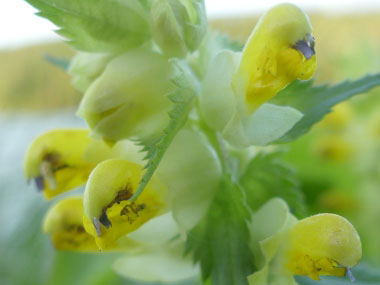
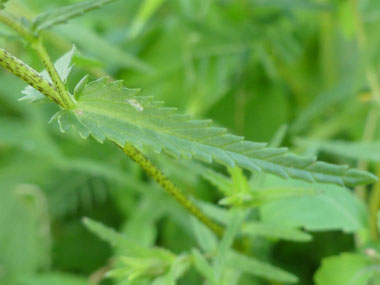
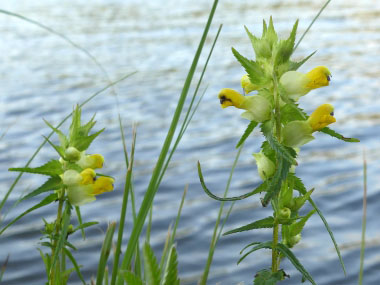
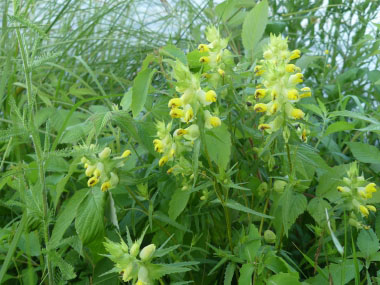
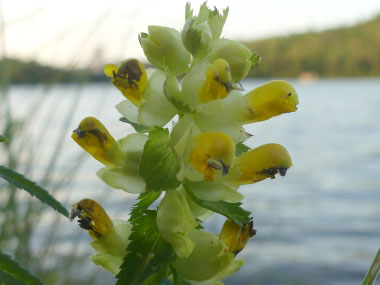
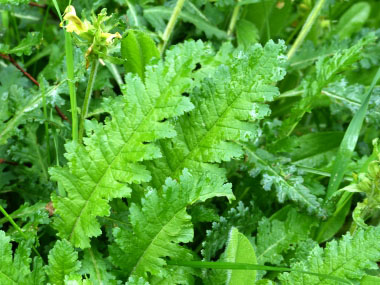
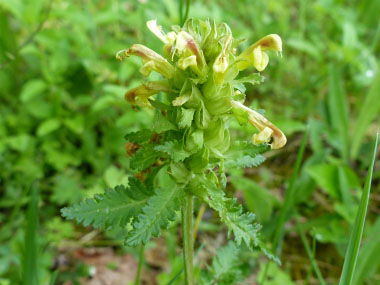
To support our efforts please browse our store (books with health benefits, etc.).
A species native to North America, the Canada Lousewort (or common lousewort) is a perennial plant in the Orobanchaceae (Broomrape) family. The USDA Plant Database shows over three dozen species in the genus, yet worldwide there are possibly hundreds of species. Canada Lousewort is a partially parasitic plant (obtaining water and nutrients from the roots of grasses and other plants). If a suitable host is unavailable or non-existent, it is capable of normal development yet; it is rarely if ever found not parasitizing other plants. Farmers once believed that after their sheep and cattle fed on lousewort, a skin disease produced by a certain tiny louse (pediculus), would harm them hence how it got its name.
Distinguishing Features
Canadian lousewort (also known as wood betony) is very showy when in full bloom. Due to its unusual flowers and foliage, it has a striking appearance. Plants form a low but dense basal rosette. The leaves are sometimes appear to be semi-evergreen, often reddish in spring or in full-sun.
Flowers
Lousewort flowers occur along a spike at the top of the stem. They are about 1 cm long, tubular, and has two lips. The upper lip curves downward, while the lower lip functions as as a landing site for insects. The flowers are usually yellow, but sometimes brownish red. The lower lip of the flower is usually faded or white. These flowers bloom late spring and lasts about three weeks. There is a mild floral fragrance that is not always detectable, although bees and other insects can detect it. The flowers have four stamens.
 Fields
of Nutrition has medicinal benefits and vitamin/mineral content of Canada Lousewort.
Fields
of Nutrition has medicinal benefits and vitamin/mineral content of Canada Lousewort.
Leaves
The lanceolate to oblong leaves may grow to up to 20 cm, but are usually shorter. The leaf blades are pinnately dissected, usually into lobes, but small leaves are just coarsely toothed. Rosettes produce a leafy stem during early spring (late February to late May), with a terminal inflorescence. The leaves are simple, occur alternate and there is one leaf per node along the stem. Leaves have fine, soft hairs that also occur on the stem of the plant.
Height
Depending on location, this plant can grow anywhere from 22 cm to 45 cm tall.
Habitat
Lousewort prefers growing in partially to full shady areas and moist soils that have other foliage nearby. (It can grow in sunny locations, but this is not common.) Loamy, well-drained areas are also preferred locations. This specific species is common from central to eastern Canada and the United States.
Edible Parts
According to Plants for a Future, only the leaves are edible. Some websites claim that many indigenous people harvested this plant as a vegetable like spinach. However, it is advisable to have only small quantities of young leaves. Although not confirmed, this plant (because it is a parasitic plant), may absorb toxins from nearby plants hence the reason consuming ONLY small quantities.
Other Name
Wood Betony.
Similar Plants
Purple Betony.
Winter Survival Food Handbook

PDF Plant Magazines
Types of Wild Food
Geographic Zones Seasons
Disclaimer
EdibleWildFood.com is informational in nature. While we strive to be 100% accurate, it is solely up to the reader to ensure proper plant identification. Some wild plants are poisonous or can have serious adverse health effects.
We are not health professionals, medical doctors, nor are we nutritionists. It is up to the reader to verify nutritional information and health benefits with qualified professionals for all edible plants listed in this web site. Please click here for more information.
Why Edible Wild Food?
- Food costs are rising
- Free, wild food is readily abundant
- Wild food adds nutrition to your diet
- Wild food can help treat various medical conditions





